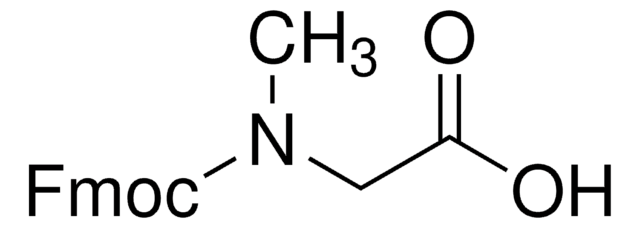推荐产品
化驗
≥80.0% (degree of coupling)
溶解度
DMF: 0.25 mg/mL, clear
螢光
λex 552 nm; λem 584 nm±10 nm in PBS, pH 7
儲存溫度
−20°C
一般說明
Absorption Maximum, λmax: 231, 308, 350 nm (non-activated, PBS, pH 7.4)
552 nm (photoactivated, PBS, pH 7.4)
Extinction Coefficient, ε(λmax): 66,000 M-1cm-1 (photoactivated, PBS, pH 7.4)
Fluorescence Maximum, λfl: 574 nm (photoactivated, PBS, pH 7.4)
Photoactivation Wavelength:360 - 440 nm
Recommended STED Wavelength, λSTED: 650 − 670 nm
Fluorescence Quantum Yield, η: 0.37 (after photoactivation, PBS, pH 7.47)
552 nm (photoactivated, PBS, pH 7.4)
Extinction Coefficient, ε(λmax): 66,000 M-1cm-1 (photoactivated, PBS, pH 7.4)
Fluorescence Maximum, λfl: 574 nm (photoactivated, PBS, pH 7.4)
Photoactivation Wavelength:360 - 440 nm
Recommended STED Wavelength, λSTED: 650 − 670 nm
Fluorescence Quantum Yield, η: 0.37 (after photoactivation, PBS, pH 7.47)
應用
- Abberior® CAGE 552 has been conjugated with secondary anti-guinea pig antibody for PALM (photo-activated light microscopy) imaging in MDA-MB-468 and COS-7 cells.
- It has been labelled with secondary antibody to perform dSTORM (direct stochastical optical reconstruction microscopy) for localization of deposited callose in destained Arabidopsis thaliana leaves.
- Abberior® CAGE 552 goat anti-mouse antibody has been used for FPALM (fluorescence photoactivation localization microscopy) imaging in NIH-3T3 fixed cells.
- It has been used for PALM imaging of silica colloids.
- It has also been used for PALM imaging of functionally asymmetric GPCR (G protein-coupled receptor) oligomers.
適合性
Designed and tested for fluorescent super-resolution microscopy
法律資訊
abberior is a registered trademark of Abberior GmbH
儲存類別代碼
11 - Combustible Solids
水污染物質分類(WGK)
WGK 3
閃點(°F)
Not applicable
閃點(°C)
Not applicable
Antonio Aloi et al.
Journal of the American Chemical Society, 138(9), 2953-2956 (2016-02-18)
The introduction of super-resolution fluorescence microscopy (SRM) opened an unprecedented vista into nanoscopic length scales, unveiling a new degree of complexity in biological systems in aqueous environments. Regrettably, supramolecular chemistry and material science benefited far less from these recent developments.
Kim C Jonas et al.
The Journal of biological chemistry, 290(7), 3875-3892 (2014-12-18)
Formation of G protein-coupled receptors (GPCRs) into dimers and higher order oligomers represents a key mechanism in pleiotropic signaling, yet how individual protomers function within oligomers remains poorly understood. We present a super-resolution imaging approach, resolving single GPCR molecules to
Steven J Tobin et al.
PloS one, 9(2), e87225-e87225 (2014-02-08)
Ethanol affects the signaling of several important neurotransmitter and neuromodulator systems in the CNS. It has been recently proposed that ethanol alters the dynamic lateral organization of proteins and lipids in the plasma membrane, thereby affecting surface receptor-mediated cellular signaling.
Michael J Mlodzianoski et al.
PloS one, 11(3), e0147506-e0147506 (2016-03-24)
Localization microscopy can image nanoscale cellular details. To address biological questions, the ability to distinguish multiple molecular species simultaneously is invaluable. Here, we present a new version of fluorescence photoactivation localization microscopy (FPALM) which detects the emission spectrum of each
Dennis Eggert et al.
Scientific reports, 4, 4159-4159 (2014-02-25)
Successful defence of plants against colonisation by fungal pathogens depends on the ability to prevent initial penetration of the plant cell wall. Here we report that the pathogen-induced (1,3)-β-glucan cell wall polymer callose, which is deposited at sites of attempted
我们的科学家团队拥有各种研究领域经验,包括生命科学、材料科学、化学合成、色谱、分析及许多其他领域.
联系技术服务部门